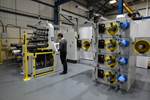Welsh dragon commission illustrates capabilities of Compcut precision composite router
The intricate dragon shape was achieved via the PCR 300 system’s hybrid precision cutting and finishing techniques available for composite materials.
A challenge for precision composite cutting — the crafting of a Welsh dragon — was undertaken by the team at Compcut, the specialist division of Sharp & Tappin (Holsworthy, U.K.), to test the capabilities of its precision composite router (PCR) 300 series. The project was commissioned by test lab R-Tech Materials (Port Talbot, Wales). The dragon symbol celebrates Wales making the World Cup for the first time since 1958.
The dragon’s emblazoned red carbon fiber was achieved using a carbon fiber coloring system developed by Hypetex (London, U.K.). The piece was laminated via resin technology at R-Tech’s test laminate manufacture facility.
Due to the complexity of the dragon’s shape, the PCR 300 system was chosen for its “hybrid” machining, which includes milling and grinding, offering R-Tech Materials a versatile range of cutting and finishing abilities that ultimately demonstrated the machine’s cutting intricacy.
The process began with machining the vac bed, on which the carbon fiber material was placed, ensuring a fixed position by vacuum pressure. A rough cut of the shape was made using a 2.5-millimeter diamond tool, before a downward blow of air pressure cleaned the panel of any excess debris. After delivering a high-quality edge and surface finish, the PCR 300 completed the task with small tool detailing from 2.5 millimeters, and as small as 0.5 millimeter.
“This was a fun exercise for the Compcut team to undertake,” Jon Small, Compcut sales manager, says, speaking about the importance of the challenge. “To challenge our PCR and reaffirm its position as an unbeaten cutting solution for refined, clean finishes to composite materials, every time. This was also a positive joint venture, demonstrating collaborative efforts with our friends at R-Tech Materials, as well as showcasing the vivid coloring technology from contributor Hypetex.”
According to Compcut, the PCR 300 is a broad utility that is safe and simple to use, providing fast and precise machining. The Welsh dragon trial has encapsulated the Compcut Challenge that has spent the year testing and showcasing the benefits of the Compcut cutting machines.
The Compcut Challenge asks businesses to question their traditional approach to cutting composite materials, by supplying their own materials to test the machines’ versatility. Producing consistently accurate test samples for precision engineering has shown to be an inconvenient activity that is slow, dirty and labor intensive.
The Compcut Challenge has been taken up by businesses such as the National Composites Centre (NCC, Bristol, U.K.), in which its PCR efficiently cut dog bone-shaped specimens from ceramic matrix composite (CMC) materials. Further accreditation has come from Composite Test & Evaluation (CTE, Honiton, U.K.). Two composite plate saws (the Compcut ACS 300 and ACS 1200) are currently in use by the center, including a PCR 300 that has significantly increased delivery of high-quality specimen manufacturing. Compcut says the accurate cutting has also led to less material waste and less harmful carbon debris in the atmosphere, improving CTE’s environmental footprint and associated health and safety impact.
To submit a material for testing, fill in the form on the Compcut website.
Related Content
-
Natural fiber composites: Growing to fit sustainability needs
Led by global and industry-wide sustainability goals, commercial interest in flax and hemp fiber-reinforced composites grows into higher-performance, higher-volume applications.
-
Infinite Composites: Type V tanks for space, hydrogen, automotive and more
After a decade of proving its linerless, weight-saving composite tanks with NASA and more than 30 aerospace companies, this CryoSphere pioneer is scaling for growth in commercial space and sustainable transportation on Earth.
-
Combining multifunctional thermoplastic composites, additive manufacturing for next-gen airframe structures
The DOMMINIO project combines AFP with 3D printed gyroid cores, embedded SHM sensors and smart materials for induction-driven disassembly of parts at end of life.

















